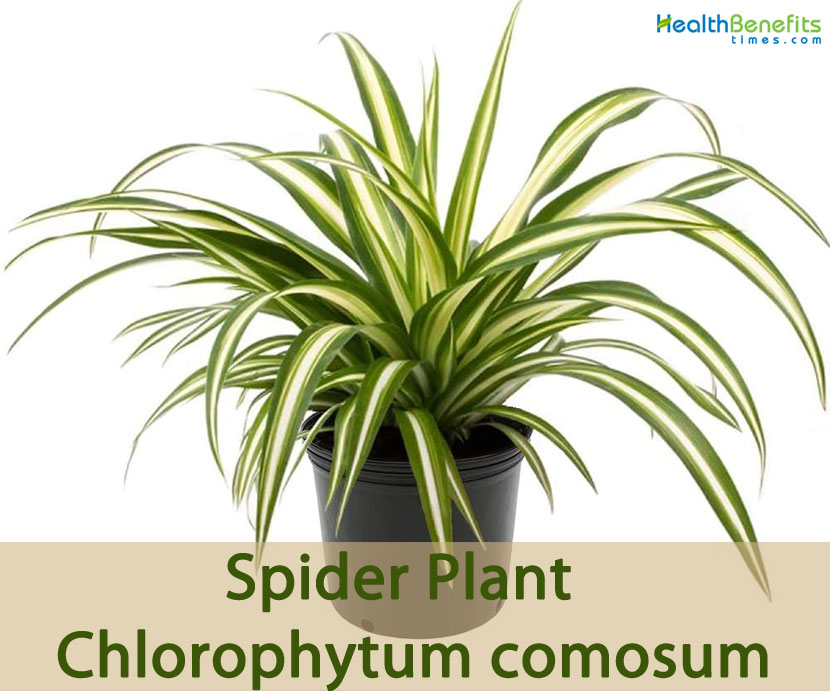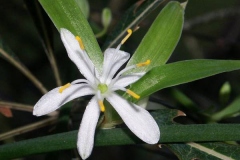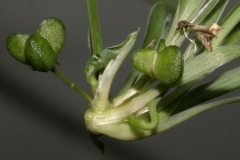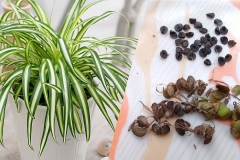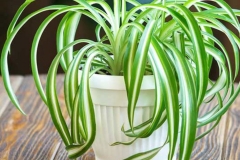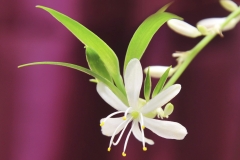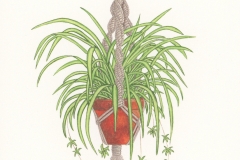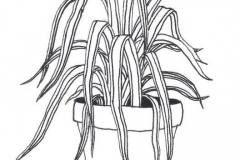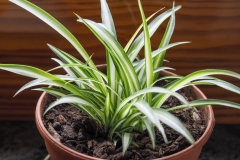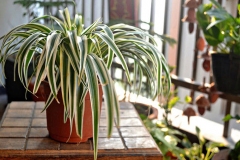Genus name Chlorophytum relates to the leaves of the plants and comes from the Greek words chloros meaning green and phyton meaning a plant. Although this may be true for some species, the vegetative parts are green and not yellow-green in C. comosum. The specific epithet comosum also refers to the leaves. Coma is derived from the Greek word kome, a tuft of hairs, and relates to the leaves arranged in a rosette. Variegatum has margins of white or cream. Vittatum has recurved leaves with a central white stripe and green margins. Spider Plant is a common houseplant often grown in hanging baskets. In warmer areas of the state it is sometimes planted as a groundcover in shady areas or as filler in flower beds. Several cultivars with variegated foliage are available.
Spider Plant Facts
| Spider Plant Quick Facts | |
|---|---|
| Name: | Spider Plant |
| Scientific Name: | Chlorophytum comosum |
| Origin | Tropical and southern Africa |
| Shapes | Tiny triangular deeply lobed three-celled leathery capsule, 3–8 mm (0.1–0.3 in) long |
| Health benefits | Healthy liver, Cure cough and cold, Potential prebiotic, Anti-cancerous, Bone healing and burn |
| Name | Spider Plant |
|---|---|
| Scientific Name | Chlorophytum comosum |
| Native | Tropical and southern Africa. Spider Plant has been reported as introduced in Australia and the southern United States (Alabama, Florida, and Georgia). In Alabama it has been collected as an escape in Conecuh County |
| Common Names | Airplane Plant, Hen-And-Chickens, Ribbon plant, Spider-Ivy, Spider plant, Walking Anthericum, bracket plant, St. Bernard’s lily, Tufted bracket plant |
| Name in Other Languages | Afrikaans: Spinnekopplant, Hen-met-kuikens, Iphamba Albanian: Bimë merimangë Amharic: Yeshererīti tekili (የሸረሪት ተክል) Arabic: Masnie aleankabut (مصنع العنكبوت), ghilan wahif (غيلان واحف) Armenian: Sardi buys (սարդի բույս) Azerbaijani: Hörümçək bitkisi Bengali: Mākaṛasā gācha (মাকড়সা গাছ) Bulgarian: Payak rastenie (паяк растение) Burmese: P ng kuu a pain (ပင့်ကူအပင်) Chinese: Zhīzhū zhíwù (蜘蛛植物), diào lán, Dian lan (吊兰) Croatian: Biljka pauka Czech: Pavoučí rostlina, Zelenec chocholatý Danish: Edderkopplante, Væddeløber Dutch: Spin plant, graslelie English: Ribbon plant, Spider plant, Spider-ivy, bracket plant, walking anthericum, hen ans chickens, St. Bernard’s lily, Tufted bracket plant, Airplane plant Esperanto: Aranea planto Estonian: Ambliktaim, tups-rohtliilia Filipino: Halaman ng spider Finnish: Hämähäkki kasvi, Kirjorönsylilja French: Plante araignée, phalangère, rubanier, Herbe vaudoise Georgian: Obobis mtsenare (ობობის მცენარე) German: Spinnenpflanze,Fliegender Holländer, Grünlilie Greek: Fytó aráchnis (φυτό αράχνης) Gujarati: Spā īḍara plānṭa (સ્પાઈડર પ્લાન્ટ) Hausa: Gizo-gizo Hebrew: צמח עכביש Hindi: Makadee ka paudha (मकड़ी का पौधा) Hungarian: Pók növény, Csüngő csokrosinda Icelandic: Kóngulóar planta Indonesian: Tanaman laba-laba, Tanaman Irish: Planda damhán alla Italian: Pianta ragno, falangio Japanese: Kumo shokubutsu (クモ植物), orizururan (オリヅルラ) Javanese: Tanduran laba-laba Kannada: Jēḍa sasya (ಜೇಡ ಸಸ್ಯ) Kazakh: Pawk ösimdigi (паук өсімдігі) Korean: Geomi sigmul (거미 식물), jeop ran, jeoblan (접란) Kurdish: Nebatê spider Lao: Phud aemngmum (ພືດແມງມຸມ) Latin: Plant aranea Latvian: Zirnekļa augs Lithuanian: Voras augalas Macedonian: Rastenie pajak (растение пајак) Malagasy: Zavamaniry Malay: Tumbuhan labah-labah Malayalam: Cilanti plānṟ (ചിലന്തി പ്ലാന്റ്) Maltese: Pjanta tal-brimba Marathi: Kōḷī vanaspatī (कोळी वनस्पती) Mongolian: Aalzny urgamal (аалзны ургамал) Nepali: Mākurō bōṭa (माकुरो बोट) Norwegian: Edderkoppplante Oriya: ସ୍ପାଇଡର ଉଦ୍ଭିଦ | Pashto: د مایع نبات Persian: گیاه عنکبوتی Polish: Pająk roślin, Zielistka Sternberga Portuguese: Planta aranha, Clorofito, Gravatinha, Punjabi: Makaṛī dā paudā (: ਮੱਕੜੀ ਦਾ ਪੌਦਾ) Romanian: Plantă păianjen, Planta-păianjen Russian: Pauk zavod (паук завод), khlorofitum khokhlatyy (хлорофитум хохлатый) Serbian: Biljka pauka (биљка паука) Sindhi: ڪوريئڙي جي پوک Sinhala: Makuḷu śākaya (මකුළු ශාකය) Slovak: Zelenec chochlatý Slovenian: Pajka rastlina Spanish: Planta araña, mala madre, cinta, lazo Sudanese: Pepelakan lancah Swedish: Spindelväxt, Ampellilja Tajik: Rastanii tortanak (растании тортанак) Tamil: Cilanti ālai (சிலந்தி ஆலை) Telugu: Spaiḍar plāṇṭ (స్పైడర్ ప్లాంట్) Thai: Phụ̄ch mængmum (พืชแมงมุม), Ṣ̄ers̄ʹṭ̄hī reụ̄xn nxk (เศรษฐีเรือนนอก) Turkish: Kurdele çiçeği Ukrainian: Pavukova roslyna (павукова рослина), Khlorofitum khokhlatyy (Хлорофітум хохлатий) Urdu: مکڑی کا پودا Uzbek: O’rgimchak o’simlik Vietnamese: Mạng nhện Welsh: Planhigyn pry cop Zulu: Isitshalo sesicabucabu |
| Plant Growth Habit | Grass-like evergreen, clump-forming, perennial, herbaceous plant |
| Growing Climates | Occurs in the undergrowth of forested river valleys, mountainous regions and thickets, on steep embankments, flat terrain and cliffs |
| Soil | Grows on a variety of soils (volcanic or sedimentary) derived from sandstone, shale, dolorite or granite. The soils are usually slightly acidic |
| Plant Size | 25-35 cm in height and 60-90 cm in width |
| Root | Primary roots are fleshy, thickened and fusiform. They are opaque white. Roots are 10-15 cm long and 1-2 cm in diameter |
| Shoots | They are the characteristic shoots that grow sideways. From each nobe of the stolon, the spiderettes form leaves and roots. |
| Stem | Vegetative stems are short and stout with very short internodes, while flower stalks are stiff, wiry, and lightly scabrous |
| Leaf | Long narrow leaves reach a length of 20–45 cm (8–18 in) and are around 6–25 millimeters (0.2–1.0 in) wide |
| Flower | Flowers are star-like shape, greenish-white, borne on stalks (pedicels) some 4–8 mm (0.2–0.3 in) long. Each flower has six triply veined tepals which are 6–9 mm (0.2–0.4 in) long and slightly hooded or boat-shaped at their tips. |
| Fruit Shape & Size | Tiny triangular deeply lobed three-celled leathery capsule, 3–8 mm (0.1–0.3 in) long |
| Seed | Seeds are flattish, black and shiny |
| Propagation | By division of rhizomes and from plantlets |
| Plant Parts Used | Roots |
| Health Benefits |
|
| Precautions |
|
Plant Description
Spider Plant is a grass-like evergreen, clump-forming, perennial, herbaceous plant that normally grows about 25-35 cm in height and 60-90 cm in width. The plant is found growing undergrowth of forested river valleys, mountainous regions and thickets, on steep embankments, flat terrain and cliffs. It was found growing in a disturbed urban woodlot on the slopes of a small stream. It grows on a variety of soils (volcanic or sedimentary) derived from sandstone, shale, dolorite or granite. The soils are usually slightly acidic.
Roots
Spider Plant has a dense root system consisting of thickened elongated white fleshy tubers and fine roots. The tubers have a conical shape at ends, their length being between 5 and 10 cm (2-4 in) and their diameter between 0.5 and 1 cm (0.2-0.4 in).
Stolons
They are the characteristic shoots that grow sideways. From each nobe of the stolon, the spiderettes form leaves and roots. With spiderettes the plant spreads vegetatively and it is a way without difficulty to propagate the Spider Plant.
Stem / Bark
Vegetative stems are short and stout with very short internodes, while flower stalks are stiff, wiry, and lightly scabrous; viviparous plantlets form on the terminus of these stalks and produce fleshy aerial rootlets. Tiny green buds are largely encased in the rosette at the base of the plant, or elongate shortly after formation on the wiry arching flower stalks. Bark are not applicable.
Leaves
Leaves rise directly from the rhizome to form a rosette. They are simple, without petiole, linear-lanceolate, of alternate arrangement and have a deep green color. The lamina is flat, with parallel ribs, entire or slightly undulate margined, leading to a pointed tip. The dimensions of the leaves vary in length between 20 and 45 cm (7.8-17.7 in) and in the width between 0.6 and 2.5 cm (0.23-0.98 in). Leaves of most cultivars are streaked with white to creamy yellow variegation, while the species type is green alone.
| Leaf arrangement | Most emerge from the soil, usually without a stem |
| Leaf type | Simple |
| Leaf margin | Entire |
| Leaf shape | Linear |
| Leaf venation | Parallel |
| Leaf type and persistence | Evergreen |
| Leaf blade length | 12 to 18 inches |
| Leaf color | Variegated |
| Fall color | No fall color change |
| Fall characteristic | Not showy |
Flowers
Flowers are produced in a long, branched inflorescence, which can reach a length of up to 75 cm (30 in) and eventually bends downwards to meet the earth. Flowers initially occur in clusters of 1–6 at intervals along the stem (scape) of the inflorescence. Each cluster is at the base of a bract, which ranges from 2–8 cm (0.8–3.1 in) in length, becoming smaller towards the end of the inflorescence. Most of the flowers which are produced initially die off, so that the inflorescences are relatively sparsely flowered.
Individual flowers are star-like shape, greenish-white, borne on stalks (pedicels) some 4–8 mm (0.2–0.3 in) long. Each flower has six triply veined tepals which are 6–9 mm (0.2–0.4 in) long and slightly hooded or boat-shaped at their tips. Stamens consist of a pollen-producing anther about 3.5 mm (0.1 in) long with a filament of similar length or slightly longer. The central style is short and smooth about 3–8 mm (0.1–0.3 in) long with a tiny and capitate stigma.
| Flower color | White |
| Flower characteristic | Flowers periodically throughout the year |
Fruits
Fertile flowers are followed by tiny triangular deeply lobed three-celled leathery capsule, 3–8 mm (0.1–0.3 in) long, on stalks (pedicels) which lengthen to up to 12 mm (0.5 in). Each cell bears 3-5 smooth and flat black seed
| Fruit shape | Pod or pod-like |
| Fruit length | Less than .5 inch |
| Fruit cover | Dry or hard |
| Fruit color | Unknown |
| Fruit characteristic | Inconspicuous and not showy |
Spider Plant health benefits
The roots of the Spider plants have wonderful medicinal value. In Chinese tradition, the roots of spider plants are used for the treatment of bronchitis, burn, and bone fracture. Listed below are few of the health benefits of using spider plant
1. Healthy liver
Root extracts of spider plants are used to study the hepato-protective activity in rats. The extracts of the spider plant root help in reducing the inflammatory process of the liver thus help in healing.
2. Potential prebiotic
Spider plant leaves helps in establishing the intestinal microorganisms thus acts as a potential prebiotic substance for a healthy bowel movement and healthy stomach.
3. Anti-cancerous
Roots of spider plants have been researched against 4 different human cell lines mainly HeLa, HL-60, and U937 for different types of tumors. The root extracts, thus, helps in suppressing the tumor activity by apoptosis or death of the cell. Although further detailed experiments are yet to be done.
4. Cure cough and cold
Spider plant absorbs water through its root and circulates through its stems and leaves. When water reaches the leaves; it will evaporate & increase the humidity. The increased humidity decreases the airborne disease like cold, cough, sore throat and flu. Whole plant extract of Spider plants helps in reducing the cough and thus relaxing the chest congestion. In Chinese tradition, the extract of the spider plant is used against bronchitis and cough-related problems.
5. Bone healing and burn
Chinese tradition uses spider plant extract for healing fractured bone and burns.
Other Interesting benefits of Spider plant
1. Almost Hard To Kill
There are some houseplants that can pretty much grow themselves; the spider plant is one of them. It can thrive well and easily adapt to various climatic conditions even when neglected for days, overwatered or under-watered. Spider plant grows well in both low light and part sunlight but it is suggested to keep this plant in a spot with bright indirect sunlight.
2. Purifies the Air
Spider plant is considered among the easiest air-purifying plants to grow. It is effective in removing harmful chemicals from the air, such as carbon monoxide, xylene, formaldehyde and toluene. According to NASA reports, the spider plant is among the top 3 types of houseplants that are great at removing formaldehyde, which is a common household chemical and generally found in manufactured wood products, plastic products, pesticides, leather goods, adhesives, clothing and drapes, etc.
3. Safe for Pets
According to the American Society for the Prevention of Cruelty of Animals (ASPCA), the spider plant is listed as non-toxic for pets. But it is still recommended to keep pets away from this plant and do not let them eat the leaves as that may pose a potential risk. The spider plant consists of chemical compounds that are said to be related to opium, which may give the pet an upset stomach, vomiting or diarrhea.
4. Speeds Recovery of Patients
According to multiple scientific researches, adding the spider plant to hospital rooms speeds up the recovery rate of surgical patients compared to patients in rooms without the plant. The patients require less pain medication, do not suffer from blood pressure or heart rate issues, experience less anxiety or depression and are released from the hospital sooner.
5. Increases Humidity
Spider plant is a perennial with a high transpiration rate. It absorbs water through its roots and then circulates the moisture through stems and leaves. Once the water reaches the leaves, it evaporates into the air and increases the humidity. The increased humidity decreases the risk of several airborne diseases, such as cold, cough, sore throat and flu-like symptoms. Growing spider plants at home or office helps in keeping these diseases away and helps increase the concentration and productivity.
6. Removes Toxic Substances from Your Home
This houseplant is the easiest species to grow. It effectively removes harmful and poisonous chemical substances such as xylene, carbon monoxide, toluene, and formaldehyde from the atmosphere.
It is excellent at eradicating formaldehyde, a household chemical compound found in leather goods, plastic products, clothes, adhesives, manufactured wood products, etc. It helps minimize carbon monoxide levels, thus reducing anxiety, constant headache, and common colds. It can prevent severe health risks such as loss of attention, vision impairment due to toluene.
Traditional uses and benefits of Spider Plant
- The plants have been used medicinally by the Nguni, particularly for pregnant mothers and as a charm to protect the mother and child.
- Roots are dipped into a water bowl and mothers drink this daily as it is believed to protect the infant.
- In Chinese tradition, the extract of the spider plant is used against bronchitis and cough related problems.
- Chinese tradition uses spider plant extract for healing the fractured bone and burns.
- Spider plant leaves helps in establishing the intestinal microorganisms thus acts as a potential prebiotic substance for a healthy bowel movement and healthy stomach.
- Infusion is given to young babies as purgative.
Other Facts
- Spider plants are non-toxic to humans and pets, and are considered edible.
- In South Africa they are grown as pot plants, in hanging baskets or as ground cover under trees.
- The species is also very effective on steep embankments to combat soil erosion.
- It is treated as a trendy houseplant in many countries.
- Pet owners may find that some cats like to eat the leaves for digestion.
- Spider Plant is one of the most useful and highly ornamental indoor plants.
- It is used in traditional systems of medicine including Ayurveda, Unani, and homeopathy.
- Spider plants can be damaged by fluoride or boron.
- Spider plants are great indoor air cleaners, and 15 spider plants would purify the air of an average size house.
Planting Methods
- Grow in a soil-based, well-draining potting mix. Spider plants like even moisture; they don’t like to be too dry or too wet.
- Keep plants in bright to moderate indirect sunlight. Spider plants do not appreciate direct, hot sunlight, which can burn their leaves, causing brown tips and spots.
- Spider plants grow fairly quickly and can easily become pot bound. Plan to repot a spider plant about every other year.
- Spider plants can be grown outdoors as annuals during the summer. They look especially good along the edge of a container or bed, as long as they are kept out of direct sunlight.
Caring Methods
- During initial growth, water occasionally; once fully developed (within one year), water moderately.
- In the spring and summer months, keep the soil moist to encourage growth. Do not let soil dry out too much.
- Maintain average room temperature and humidity. Spider plants prefer temperatures between 55 and 80°F (13–27°C), which makes them a great indoor houseplant.
- Fertilize up to twice a month in the spring and summer, however, avoid over fertilization.
Tips for repotting your Spider Plant
- Once the pot becomes full, you can separate the baby plants (also known as “pups”) from the pot and plant them in another pot.
- When you transfer plant from smaller to larger pots; make sure the larger pots have good drainage hole (as it could not tolerate wet condition).
- Some healthy mother spider plant can produce pups that hang down. You can repot them as well.
- While repotting these pups you can replant them another pot next to the mother plant.
- When the pups will be rooted, you can simply cut the attached stem from mother plant.
Some additional points to Remember
- Do not overwater your spider plant. Watering twice weekly is enough.
- Do not keep the spider plant under direct sunlight for more than 6 hours.
- Repotting your spider plant is a must.
- Notice for any fungal infections in your plants. Your plant will not grow properly and eventually die. So, remove this part to prevent further spreading.
- Adding coco pit in the soil mixture is very beneficial to your Spider plant.
References:
https://www.itis.gov/servlet/SingleRpt/SingleRpt?search_topic=TSN&search_value=810167#null
http://www.hear.org/pier/species/chlorophytum_comosum.htm
https://www.missouribotanicalgarden.org/PlantFinder/PlantFinderDetails.aspx?kempercode=b547
https://en.wikipedia.org/wiki/Chlorophytum_comosum
https://npgstest2.agron.iastate.edu/gringlobal/taxon/taxonomydetail?id=10301
https://aggie-horticulture.tamu.edu/syllabi/308/Lists/Fourth%20Edition/Chlorophytumcomosum.pdf
https://www.cabi.org/isc/datasheet/12469
https://indiabiodiversity.org/species/show/229155
http://www.theplantlist.org/tpl1.1/record/kew-302261
https://irjponline.com/admin/php/uploads/2202_pdf.pdf
https://davesgarden.com/guides/pf/go/68558/#b
https://plants.usda.gov/home/plantProfile?symbol=CHCO28
https://gd.eppo.int/taxon/CFYCO
http://pza.sanbi.org/chlorophytum-comosum


